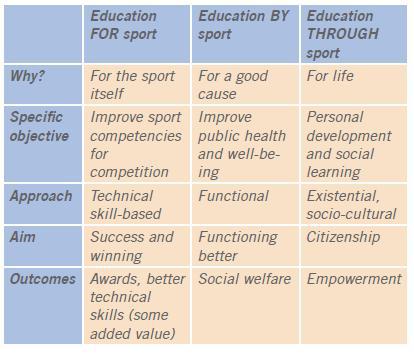Education by, for and through sport? What is the difference?
We know, it can be confusing :) We did our best to summarise each conception, their differences and potentials. Of course that you can read a more comprehensive explanation on the complete MOVE&Learn manual (page11)

By, for and through Sport (MOVE&Learn manual p.12)
Education for Sport
Many traditional sports clubs are mainly mobilised by sports performance goals as their priority. Here we evoke the concept of Education FOR Sport, which has the main aim of developing competences in terms of sport performance. Education for Sport addresses the improvement of skills related to the sport itself. Thus, its purpose is only to serve the development of individual competences to improve physical performance. Education for Sport is normally related to diverse disciplines of competitive sport. This concept therefore has limited interest in the context of non-formal education.
Education by Sport
The concept of Education BY Sport is more complex process and includes specific objectives such as the aim to address health issues and wellbeing. In this case, the educational goals are not abandoned but they are sometimes relegated to the second plan. The aim is therefore to reconcile the sporting goals and the wellbeing of the society. It uses sport, exercise and physical activity to work towards social causes such as health, wellbeing, public welfare or social inclusion. The new “sport for all” movements are very close to this approach. By playing different sports, it is expected that people learn more about healthy lifestyles and in this way raise their awareness about the mentioned issue in general.
Education through Sport (ETS)
ETS creates existential learning between people. Through ETS a lasting social change is supposed to happen. It aims to enable empowerment and provoke a sustainable social transformation. ETS requires many elements which go from using sport and physical exercise in order to provoke a strong lifelong learning outcome such as improving tolerance, solidarity or trust among nations. ETS should be seen more as a plan for reflection than for a field action.
From a methodological perspective, ETS consists of adapting sport and physical activity exercises to the objectives of the planned learning project. It is a matter and a process of adaptation of sport and physical activity, both in terms of their expression and their representation, which characterises specifically the ETS approach. It does not propose any actions where sport becomes a central objective as/for a carrier solution. For instance, the practice of a martial arts without any specific project behind it, led only by the desire for technical progress, remains a FOR sport involvement, but it may also develop self-control and respect for others. The important matter here is to conduct a process where sport and physical activities become tools for support to achieve the educational goals first, where the sport itself becomes secondary to the educational purpose.
Remember! You can read more on page 11 of the MOVE&Learn manual!
Would you like more?
Download the completeMOVE&Learn manual